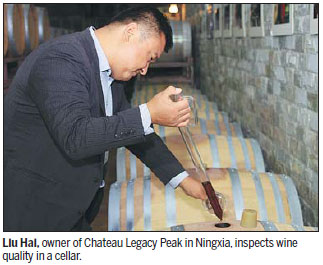Chateau's legacy bodes well for area's aspiring vineyards
The eastern foot of the Helan Mountain in the Ningxia Hui autonomous region, although known as a newly emerged wine region in China, does not lack for aged grapevines.
Chateau Legacy Peak, founded in 2013, has grapevines of around 20 years of age in Ningxia. The vines planted by the current owner's father in 1997 were among the first batch of Cabernet grapes introduced to Ningxia.
Liu Hai, the vinyard's owner, described his first encounter with the grapes as a "coincidence", because at first, his family's land was designed to produce red grapes for eating, rather than Cabernet.
However, the red grape seedlings proved insufficient for the whole area of Liu's land, so the family decided to plant wine grapes on the remaining sections of the 13.33 hectares of land.
"Our winery was the first to plant these grapes in this mountainous region. At that time, we didn't have any experience to learn from," Liu said.
"At first, the cost of removing the stones and the overall field management in this mountainous area was much higher compared to that in sandy soils. The wine grapes couldn't sell for a good price on the Chinese market. The high input and low payback drove us to make a painful decision - to let the wine grapevines grow and die in their own course," Liu said.
In 2010, Liu's father wanted to quit his job and let his sons inherit the vineyard or else just sell it.
"However, my mother was strongly opposed to the decision to sell the field. She urged us to come back to run the vineyard, so I undertook the task," Liu said.
The year 2011 marked the starting point for Chateau Legacy Peak making wines. From a fruit grower to a winery owner, Liu experienced a great transformation.
Gradually, Liu discovered that the alluvial fan-shaped soil created by the impact of raindrops on the Helan Mountain resulted in a layer of sand and a layer of gravel in the earth, providing a good foundation for grapevines to root down deeply into the soil.
The deeper the vines are, the more mineral substances and phenolic compounds they can take in. Gradually, the chateau improved its winemaking techniques and has received good market feedback.
The secret of Liu's wine is to work with nature, said Zhou Shuzhen, a winemaker in Chateau Legacy Peak.
"Throughout our winemaking process, we tried to highlight the natural characteristics of the grapes in the wines, instead of using food additives to change its natural beauty," Zhou said.
At first, the grape growers lost confidence as their fruit did not sell well. But after 20 years, in 2016, the total sales revenue of the winery hit 14 million yuan ($2.09 million), according to Liu.
Tony Kalleske, an Australian winemaker who worked in Chateau Legacy Peak, said: "Ningxia has a bright future ahead both for winemaking and tourism, with its natural rugged beauty and long, rich history. The bottles of Legacy Peak Cabernet and Chardonnay that I brought back to Australia were well received and surprised many people with their quality."
liyou@chinadaily.com.cn

(China Daily 08/29/2017 page12)













